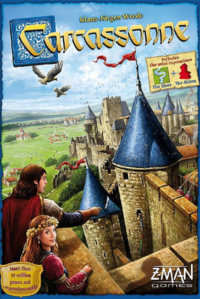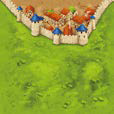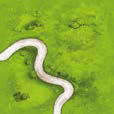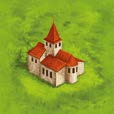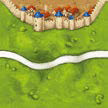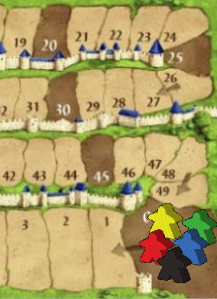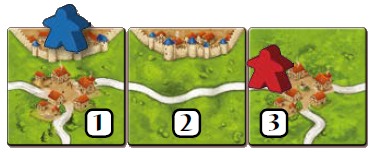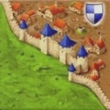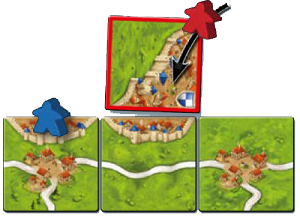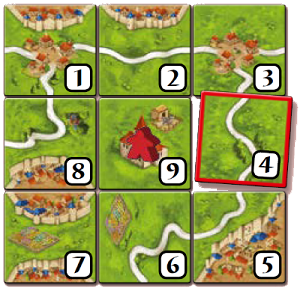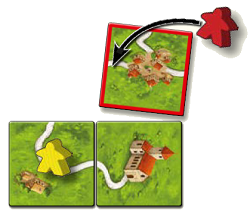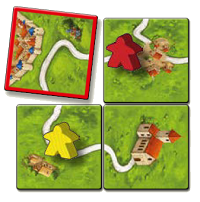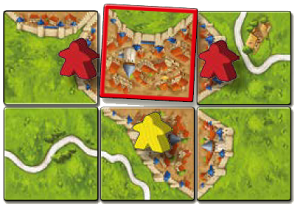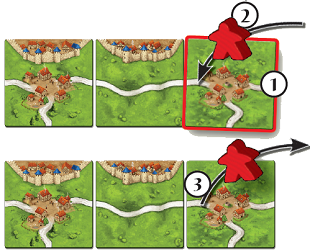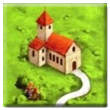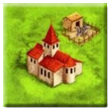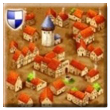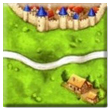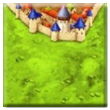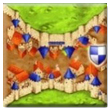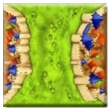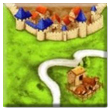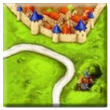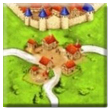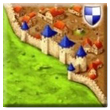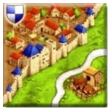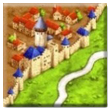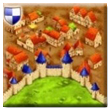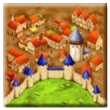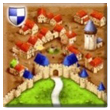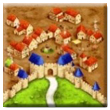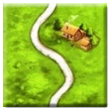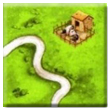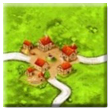Grundspiel
Allgemeine Informationen und Kommentare
Ursprünglich von Hans im Glück im Template:Year de herausgegeben.
Carcassonne, the world-famous French city, is known for its imposing fortifications erected during Antiquity and the Middle Ages. This fortress, surrounded by magnificent walls, still stands today as one of the most unique French cities. In this game, players must develop the area around Carcassonne. They place their followers onto roads and into cities, monasteries, and fields. Only those who make the most judicious placements will gain the points required to win the game.
Information zu der Bauernregel
Bauern werden für die meisten Carcassonnespieler als Bestandteil des Grundspiels angesehen. Sie werden auch in jedem offiziellem Turnier benutzt, da sie oft nicht als Erweiterung betrachtet werden. In der neuen Edition von Carcassonne wurden Bauern als eine Vervollständigung getrennt, um für eine glatte Lernkruve zu erzeugen und um den Zugang zu dem Spiel für neue Spieler zu erleichtern. WikiCarpedia folgt dieser stromlinearen Annäherung. Für das Schicksal von anderen Erweiterungen und den Rest von WikiCarpedia werden Bauern als Teil des Grundspiels betrachtet. Sie können die Bauernregel hier Die Bauernhöfe finden.
Komponenten und Aufbau
Der folgende Teil erklärt das anfängliche Setup und stellt Komponenten des Spiels vor.
Die 72 Karten zeigen Straßen, Städte und Klöster auf einer Wiese.
Die Rückseiten der Karten sind gleich, aber die STARTKARTE hat eine dunkler gefärbte Rückseite, sodass man sie leicht erkennen kann. Andere grafische Elemente wie Häuser, Leute oder Tiere haben keinen Einfluss auf das Spiel.[1]
Legen Sie die Startkarte (die mit einer dunklen Rückseite) in die Mitte des Tischs.[2]. Mischen Sie die übrigen Karten und setzen Sie diese als verschiedene Stapel mit der Bildseite nach unten ab.[3] die leicht für alle Spieler zugänglich sind.
Dann kommt die Punktetafel, die Sie zur Seite ihrer Spielfläche stellen (Tisch, Boden, etc.).
Schließlich haben wir die Meeple. Sie werden in der Box 40 normale Meeple vorfinden, darunter 8[4]Meeple in jeder dieser Farben: gelb, rot, grün, blau, schwarz[5]Zusätzlich gibt es noch 5 Äbte.<![]() Die Nutzung der Äbte wird auf der Minierweiterungsseite der Abt, welche einen in jeder Farbe enthält, beschrieben.
Die Nutzung der Äbte wird auf der Minierweiterungsseite der Abt, welche einen in jeder Farbe enthält, beschrieben.
Starten Sie indem sie jedem Spieler 7 Meeple in der Farbe ihrer Wahl geben. Diese Meeple bilden den persönlichen Vorrat jedes Spielers.Platzieren sie den achten Meeple jedes Spielers auf den 0-Platz auf der Punktetafel. Diese werden benutzt um durchwegs des Spiels die Punkte jedes Spielers zu verfolgen. Wenn Sie nicht mit der Abt spielen, tun sie diese einzigartigen Meeple zurück in die Box.
Überblick und Ziel der Spiels
In Carcassonne, players take turns placing tiles and expanding the landscape of roads, cities, monasteries and fields, one tile at a time. Players may place their meeples on the individual features of tiles as well (roads, cities, monasteries, and fields), where they will become highwaymen, knights and monks. Points are earned throughout the game, and the player with the highest score at the end is the winner!
Gameplay
A game of Carcassonne is played in clockwise order. Starting with the youngest player[6], the current player does the following actions in the order listed below, after which it is the next player’s turn, and so on and so forth. First, we’ll give you a brief description of the actions you have to do during one of your turns. These actions will be detailed as we present the roads, the cities, and finally the monasteries. So what are these actions?
- Placing a tile: The player must draw exactly 1 Land tile from a stack and place it faceup to continue the landscape.[7][8][9]
- Placing a meeple: The player may place a meeple from their supply onto the tile they have just placed.
- Scoring a feature: The player must score any feature completed by the tile placement.
The roads
Placing a tile
You draw the depicted tile with three road segments starting from a village. You must place it in such a way that it continues the existing landscape (the tiles already in play)[10]. In the rare case that a tile cannot legally be placed anywhere, and all players agree, it is removed from the game, and the player draws another. [11]
Placing a meeple as highwayman
After placing the tile, you may place a meeple as a highwayman on one of that tile’s road segments, but only if the road is unoccupied by another highwayman.
In our example, since the road is not yet completed, no scoring occurs (see action 3) and play moves on to the next player.
The next player draws a tile that he/she places to continue the landscape. They may not place a meeple on the road to the right since your highwayman is already present on that road. Instead, they choose to place their meeple as a knight in the city segment of that tile.
Scoring a road
When both ends of a road are closed, that road is completed and scored. The end of a road is closed when it meets a village[12], a city, a monastery, or it loops onto itself by meeting the other end.[13]
Even though it is your opponent that placed the tile, this still completes your road. How many points do you score? When scoring a road, each tile of that road grants you 1 point. Here, since you scored a road that is made out of 3 tiles, you score 3 points.
It is now time to note your score. You keep track of your score with the meeple you placed on the scoreboard before starting the game. Continuing our example, you move it forward 3 spaces to show that you’ve scored 3 points. Note: if your score passes 50 points, lay down your scoring meeple to show your 50+ points. After each scoring, return to your supply the meeple that was just scored.
We’ve already seen the most important parts of the game. Now, we will further expand on those actions by showing you how they apply to the other features, namely the cities and the monasteries:
The cities
Placing a tile
Placing a meeple as a knight
Scoring a city
Let’s continue our example and assume that a few turns have passed. You now draw this tile that you place to continue your city. Since the tile you’ve placed completes a feature (here, the city), it must now be scored. A city is completed when it is surrounded by walls and there are no gaps inside the city. Since you have a meeple in the completed city, you are the player to score it.
Each tile in a completed city is worth 2 points. In addition, each coat of arms is worth 2 more points.[14] For this city, you score 8 points! As usual, the meeple that was in the scored feature returns to your supply.
The monasteries
Placing a tile
Placing a meeple as a monk
Scoring a monastery
A monastery is completed when it is surrounded by tiles. During scoring, the monastery is worth 1 point per tile that completes it (including the monastery itself).
By placing this tile, you complete your monastery. It earns you 9 points and allows you to take your meeple back.
We have already seen most of the rules for Carcassonne. There are only a few points left to see, but first, here is a summary of what we’ve seen so far:
Summary
Placing a tile
- You must place your drawn tile in such a way that it continues the landscape and the illustration.
- In some very rare cases, it may be impossible to place the tile. In those cases, simply return the tile to the box and draw a new one.
Placing a meeple
- You may place a meeple on the tile you’ve just placed.
- You may not place a meeple in a feature where there already is at least one other meeple, including one of yours.
Scoring a feature
- A road is completed when both ends lead to a village, a city, a monastery, or the road forms a loop. Each tile in a completed road is worth 1 point.
- A city is completed when it is surrounded by walls and there are no holes inside the city. Each tile in the completed city is worth 2 points. Each coat of arms in the completed city is worth an extra 2 points.
- A monastery is completed when it is surrounded by 8 tiles. Each of the monastery’s tiles (the 8 surrounding tiles and the one with the monastery itself) is worth 1 point.
- Scoring always occurs at the end of a player’s turn. At that moment, each player with a meeple in a scored feature earns points.[15]
- After each scoring, return to your supply the scored meeples.
- If there are multiple meeples in a single scored feature, the player with the most meeples is awarded full points and all other players receive nothing. When more than one player have the most meeples in a scored feature, the tied players all score full points.
Game end and final scoring
The game ends immediately after the turn of the player who placed the last tile. Then, players proceed to a final scoring, after which the winner will be known.
Once the game is over, all meeples still in play are scored:
- Each incomplete road is worth 1 point per tile, just like during the game.
- Each incomplete city is worth 1 point per tile and 1 point per coat of arms, which is only half the points.
- Each incomplete monastery is worth 1 point plus 1 point per adjacent tile, just like during the game.
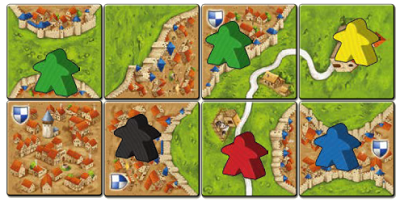
Final scoring - monastery: Yellow scores 4 points for this incomplete monastery (3 points for the adjacent tiles and 1 point for the monastery itself).
Final scoring - city: Blue scores 3 points for this incomplete city (2 tiles and 1 coat of arms).
Final scoring - road: Red scores 3 points for this incomplete roads (3 tiles).
Once the final score is known, the winner is the player with the most points.[16]
Special cases
Many meeples on the same road
Many meeples in the same city
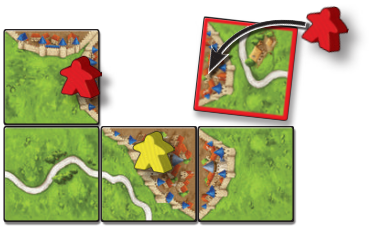
Use a Meeple, Score a Feature, and Get the Meeple Back
You can place a meeple in a feature you just completed, immediately score it, and then return the meeple to your supply.
To do so, follow these steps:[17]
__ 1. Place a tile, completing a feature (such as a road, city, or monastery).
__ 2. Place a meeple as a highwayman, knight, or monk on the feature you just completed.
__ 3. Score the completed road, city, or monastery and return the meeple to your supply.[18]
House Rules
- The players decide who starts the game by any method they choose—such as by rolling three followers. The first player to ‘roll’ a standing follower decides who plays first. (Thanks to Joff.)
- To determine the first player; each player draws a tile from the bag, the player that drew the tile with the most roads (0 to 4) plays first, if there is a tie for most roads, a draw-off takes place. This is repeated until someone wins. (Thanks to michael.)
- Take your next tile at the end of your turn, to give you time to think about placement and avoid analysis paralysis.
- Play with a three-tile hand. The abbey counts as part of your hand. Play your turn. including the builder, and then draw back up to three tiles. These tiles could be visible to all or hidden to the other players (Thanks to DavidP and youth.)
- When playing with a bag for the tiles, the original starting tile may be put into the bag, and unplayable tiles can be put back into the bag rather than set to one side. (Thanks to dwhitworth.)
- Trees (bushes) on roads do not end the road—only houses do (when the road forks). This makes road building a lot more dynamic. (Thanks to Tobias.)
- When a tile is the only tile which can currently complete a structure, other players can offer to ‘buy’ it by offering points, trades counter, abbey, and so on. (Thanks to Deatheux.)
- If you place a tile that fills a hole in the playing field by touching something on all four adjacent sides, you get another turn. This helps motivate people to finish the board even if they do not get an advantage from the placement. (Does not apply to the abbey tile). (Thanks to viberunner.)
- Incomplete features at the end of the game do not score points at the end of the game. (Thanks to metoth.)
- The edge of the table limits the playing area. Thus, a player may not place a tile past the edge of the table or move the playing area to place a tile that would have been past the edge of the table. (Thanks to metoth for prompting this one, and to SkullOne for pointing out that this is an official rule from Hunters and Gatherers.)
- Table borders COMPLETE features as an abbey would. (Thanks to PreGy.)
- Use colored dice instead of meeples on the scoring track. Start out with the 6 showing on top. When the marker completes one lap, turn it to the number 1 to indicate it has completed one lap. This shows at a glance which player is on what lap and who's ahead. On the 100 space track it’s even easier to determine someone’s score at a glance. (Thanks to Carcking.)
Use of a Table
A number of questions have been asked about rules related to the play area itself, including what happens when the edge of the area is reached, or if a table has to be used for play. The following clarifications are from Georg Wild from HiG (5/2013):
- The edge of the table is the limit for the game if, as stated in the rules, a table is used.
- The rules state that the starting tile is placed in the middle of the table. If all of the tiles are shifted to allow more room, the starting tile would no longer be in the middle. So in principle, total shifting of the tiles is not allowed. Additionally, with a manual shift of all of the tiles, the tiles and figures on the field can slip, which could lead to incorrect positioning of tiles or figures.
- Addition of a second table is possible if one of an appropriate height is added to the first table. If a table is extended (as with an additional panel), make sure that the tiles and figures on the playing field do not slip.
- Playing on the floor: The rules technically do not allow this, because the rules state that the first tile is placed in the middle of the table. Playing on the floor is not forbidden, however, if use of a table is not feasible. If the floor is used, tiles must be placed so all tiles are visible to all players. Tiles cannot be placed under the sofa, cabinet/shelf, etc.
- It is important generally, that all the players in the round agree how to play:
- Table - Standard
- Table - with "total shifting" of tiles
- Table - with extension
- Floor
- Continue to play fairly and not intentionally unfair to other players.
Tile reference
Total Tiles: 72
One of the tiles marked with "(S)" -tile number four- is the starting tile (with a dark back).
Many of the tiles have a small illustration on them. The letters in brackets show which illustration is on each tile:
Referenzen
Für Lizenzen und Erklärungen besuche Icons page.
- ↑
 Sie haben keinen Einfluss auf die Grundregeln. Diese werden oder werden wahrscheinlich in Erweiterungen benutzt werden. Z.B. Die Märkte zu Leipig
Sie haben keinen Einfluss auf die Grundregeln. Diese werden oder werden wahrscheinlich in Erweiterungen benutzt werden. Z.B. Die Märkte zu Leipig
- ↑
 Siehe auch Notizen zu Benutzung eines Tischs
Siehe auch Notizen zu Benutzung eines Tischs
- ↑
 Karten können auch in einen Sack gepackt werden und zufällig gezogen werden.
Karten können auch in einen Sack gepackt werden und zufällig gezogen werden.
- ↑
 Frage: Zu wenig Gefolgsleute - spielen wir das falsche Spiel oder gibt es wirklich zu wenig?Antwort:In unserem Blickpunkt sind es nicht zu wenig. Eine gewisse Knappheit an Gefolgsleuten ist absichtlich. Ein wichtiges Element des Spiels ist es präzise zu lernen sparsam mit seinen Gefolgsleuten zu sein.
Frage: Zu wenig Gefolgsleute - spielen wir das falsche Spiel oder gibt es wirklich zu wenig?Antwort:In unserem Blickpunkt sind es nicht zu wenig. Eine gewisse Knappheit an Gefolgsleuten ist absichtlich. Ein wichtiges Element des Spiels ist es präzise zu lernen sparsam mit seinen Gefolgsleuten zu sein.
- ↑ Soweit wie die Big Box 6 betroffen ist, ist das sechste Set (pink) Gefolgsleute Teil des Grundspiels, nicht von Wirthshäuser & Kathedrahlen .
- ↑
 It is common practice to choose starting player at random. More on this in house rules section.
It is common practice to choose starting player at random. More on this in house rules section.
- ↑
 Question: We have difficulty deciding when a placed tile represents a new city or belongs to one already being built. Answer: 'Corner to corner' is not a connection! Segments can only be connected on the edges. In the example shown there are two cities at the moment.
Question: We have difficulty deciding when a placed tile represents a new city or belongs to one already being built. Answer: 'Corner to corner' is not a connection! Segments can only be connected on the edges. In the example shown there are two cities at the moment.
- ↑
 Cloisters can be placed directly next to each other, or corner to corner. It is not necessary for there to be eight other (non-cloister) tiles neighbouring a cloister. A cloister stands in the middle of a field segment and other segments can be placed next to it. In contrast to roads, cities, and fields, it is not possible to connect to a cloister.
Cloisters can be placed directly next to each other, or corner to corner. It is not necessary for there to be eight other (non-cloister) tiles neighbouring a cloister. A cloister stands in the middle of a field segment and other segments can be placed next to it. In contrast to roads, cities, and fields, it is not possible to connect to a cloister.
- ↑
 A newly placed land tile must fit the adjacent terrain on all edges. During placement it is not enough to look for only one side that fits.
A newly placed land tile must fit the adjacent terrain on all edges. During placement it is not enough to look for only one side that fits.
- ↑
 Question: On cloister tiles, are we allowed to deploy a follower on the surrounding field segment? Answer: Yes! The same rules are valid for a field surrounding a cloister as for any other field. You can also deploy a farmer next to a cloister. In this case the cloister remains unoccupied for the rest of the game.
Question: On cloister tiles, are we allowed to deploy a follower on the surrounding field segment? Answer: Yes! The same rules are valid for a field surrounding a cloister as for any other field. You can also deploy a farmer next to a cloister. In this case the cloister remains unoccupied for the rest of the game.
- ↑
 If drawing tiles out of a bag, a tile that cannot be placed could be returned to the bag for later use.
If drawing tiles out of a bag, a tile that cannot be placed could be returned to the bag for later use.
- ↑
 Village is a little set of red roofed buildings surrounding the crossroad.
Village is a little set of red roofed buildings surrounding the crossroad.
- ↑
 Question: Can a road end in nothing? Answer: No, like all the usual land tiles, a road segment must continue to another road segment on all edges.
Question: Can a road end in nothing? Answer: No, like all the usual land tiles, a road segment must continue to another road segment on all edges.
- ↑
 Note that a coat of arms only affects the city segment it is in, not the whole tile (if there is more than one segment on a single tile).
Note that a coat of arms only affects the city segment it is in, not the whole tile (if there is more than one segment on a single tile).
- ↑
 When two followers of one color are occupying a road, city, or farm, you do not score double in these cases. The number of followers (or in Inns and Cathedrals the size of the followers) has no effect on the points that a player earns from a road, city, cloister, or farm. Two knights do not double the points. The number of followers is only important in establishing who has the majority.
When two followers of one color are occupying a road, city, or farm, you do not score double in these cases. The number of followers (or in Inns and Cathedrals the size of the followers) has no effect on the points that a player earns from a road, city, cloister, or farm. Two knights do not double the points. The number of followers is only important in establishing who has the majority.
- ↑
 Rules do not include tiebreakers. That is rules explaining situation when few players share the same score.
Rules do not include tiebreakers. That is rules explaining situation when few players share the same score.
- ↑
 Note in the box that features are considered to be complete as soon as the tile is placed, although follower placement and scoring only occur afterwards. This is important when playing with The Flier.
Note in the box that features are considered to be complete as soon as the tile is placed, although follower placement and scoring only occur afterwards. This is important when playing with The Flier.
- ↑
 Question: There is a situation that puzzles us. If a player draws a tile with two city segments and completes a small city, earning 4 points, can he or she then deploy a follower to a new city segment in the same turn? Answer: A player may only deploy one follower per turn, and that follower may be deployed only once, and it must be before any scoring. If the player already occupies the small, now-completed city, he or she may deploy a second follower to the other city segment immediately after placing the tile. The small city will then be scored and the follower involved returned to the player. If the player does not yet occupy this city, he or she can decide which of the two city segments to deploy a follower to. If the follower is deployed to the small city, it will be returned immediately and the player will earn four points, but the follower cannot be redeployed.
Question: There is a situation that puzzles us. If a player draws a tile with two city segments and completes a small city, earning 4 points, can he or she then deploy a follower to a new city segment in the same turn? Answer: A player may only deploy one follower per turn, and that follower may be deployed only once, and it must be before any scoring. If the player already occupies the small, now-completed city, he or she may deploy a second follower to the other city segment immediately after placing the tile. The small city will then be scored and the follower involved returned to the player. If the player does not yet occupy this city, he or she can decide which of the two city segments to deploy a follower to. If the follower is deployed to the small city, it will be returned immediately and the player will earn four points, but the follower cannot be redeployed.
